陕旅版五年级英语上册知识点汇总
- 格式:doc
- 大小:125.00 KB
- 文档页数:21
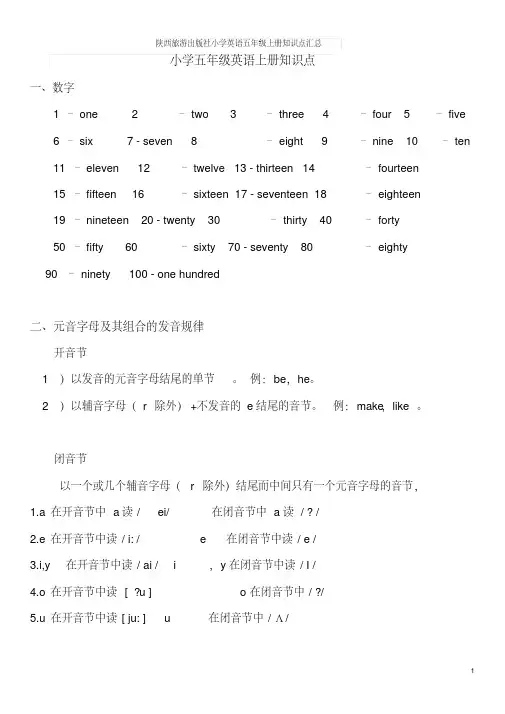
小学五年级英语上册知识点一、数字1 – one2 – two3 – three4 – four5 – five6 – six7 - seven8 – eight9 – nine 10 – ten11 – eleven 12 – twelve 13 - thirteen 14 – fourteen15 – fifteen 16 – sixteen 17 - seventeen 18 – eighteen19 – nineteen 20 - twenty 30 – thirty 40 – forty50 – fifty 60 – sixty 70 - seventy 80 – eighty90 – ninety 100 - one hundred二、元音字母及其组合的发音规律开音节1)以发音的元音字母结尾的单节。
例:be,he。
2)以辅音字母(r 除外)+不发音的e结尾的音节。
例:make,like。
闭音节以一个或几个辅音字母(r 除外)结尾而中间只有一个元音字母的音节,1.a在开音节中a读 / ei/ 在闭音节中a读/ ? /2.e在开音节中读/ i: / e在闭音节中读/ e /3.i,y 在开音节中读/ ai / i,y在闭音节中读/ I /4.o在开音节中读 [?u ] o在闭音节中/?/5.u在开音节中读[ ju: ] u在闭音节中/Λ/三、英语缩写形式及完全形式I’m = I am you’re = you are he’s = he isisn’t = is not aren’t = are notI’ll = I wil we’ll = we wilI’ve got= I have got let’s= let usdoesn’t=does not can’t= can not I’d=I would常见词组on time按时 get up 起床 of course 当然 let me try 让我试试my favorite food 我最喜爱的食物 at table 在桌子上 come in 进来play computer games 玩电脑游戏 too many 太多 come on 加油make the bed 整理床铺 sweep the floor 扫地 do the dishes 洗餐具water the flowers 浇花 clean the windows 擦窗户 cook the meal 做饭wash the clothes 洗衣服 I see 我懂了,我明白 you are welcome 别客气between the…and the…在…和…之间 Children ’s park 儿童公园take a bus 乘公共汽车 get off 下车 on the left 在左边on the right 在右边 in the middle 在中间 get to 到达how much 多少钱 a pair of 一条,一双 here you are 给你paly together 一起玩 come from 来自 a little 一点,少量 do the sports 做运动 far away 远 far from 远离名词复数 man—men child—children动词第三人称单数have—has do—does go—goes现在分词 come–coming 来 dance-dancing 跳舞 make–making 制造write-writing 写 take - taking 拿走 have—having吃swim—swimming 游泳 sit—sitting 坐 run—running跑人称代词主格、宾格人称主格宾格物主代词所有格(……的)用作主语表语宾语介词宾语后接名词;作定语单数第一人称 I(am)我 me 我 my 我的第二人称 you(are)你 you 你 your 你的第三人称He(is)他 him 他 him 他的She(is)她 her 她 her 她的it 它it its复数第一人称 We(are)我们 us 我们 our 我们的第二人称you(are)你们 you 你们 your 你们的第三人称 they(are)它们them(他/她/它)们their(他/她/它)们的连词成句习题练习1.too/fast/don’t/run2.are/again/you/late3.may/down/I/sit4.bed/I/at/ten/go/o’ clock/to5.time/have/do/breakfast/what/you6.draw/at/thirty/they/pictures/five7.are/you/helpful8.I/in/come/may9.for/you/can/what/I/do10.Miss White/is it/what/timee/with/hand/right/chopsticks/the/your12.chocolate/please/would/you/some/me/give13.far/it/from/is/here14.water/can/the/you/flowers15.your/favorite/what’s/father’s/food16.can/get/children’s park/the/how/to/we17.girl/to/a/of/pair/socks/I’d/buy/like/my/for。
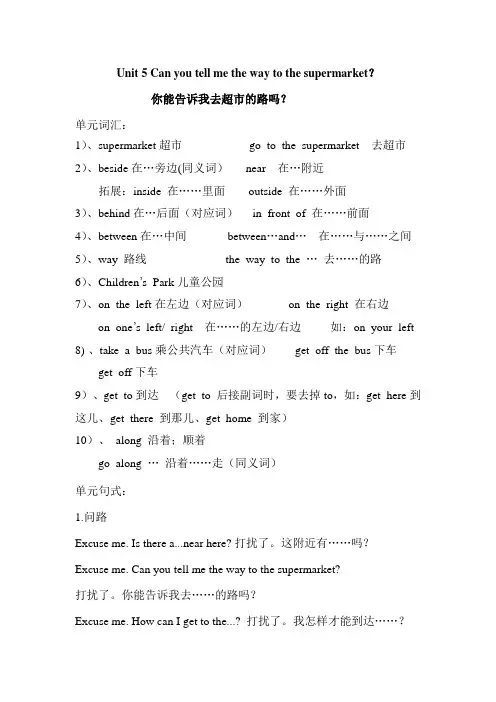
Unit 5 Can you tell me the way to the supermarket?你能告诉我去超市的路吗?单元词汇:1)、supermarket 超市go to the supermarket 去超市2)、beside 在…旁边(同义词)near 在…附近拓展:inside 在……里面outside 在……外面3)、behind 在…后面(对应词) in front of 在……前面4)、between 在…中间between…and…在……与……之间5)、way 路线the way to the …去……的路6)、Children’s Park 儿童公园7)、on the left 在左边(对应词)on the right 在右边on one’s left/ right 在……的左边/右边如:on your left 8)、take a bus 乘公共汽车(对应词)get off the bus下车get off 下车9)、get to 到达(get to 后接副词时,要去掉to,如:get here到这儿、get there 到那儿、get home 到家)10)、along 沿着;顺着go along …沿着……走(同义词)单元句式:1.问路Excuse me. Is there a...near here? 打扰了。
这附近有……吗?Excuse me. Can you tell me the way to the supermarket?打扰了。
你能告诉我去……的路吗?Excuse me. How can I get to the...? 打扰了。
我怎样才能到达……?Excuse me. Where is..., please?打扰了。
请问……在哪里?Excuse me. Which is the way to …, please?打扰了。
请问哪条路通往……?2、指路---Go along the street and you can see a hospital on the left.沿着这条街走,你可以在路左边看到一家医院。
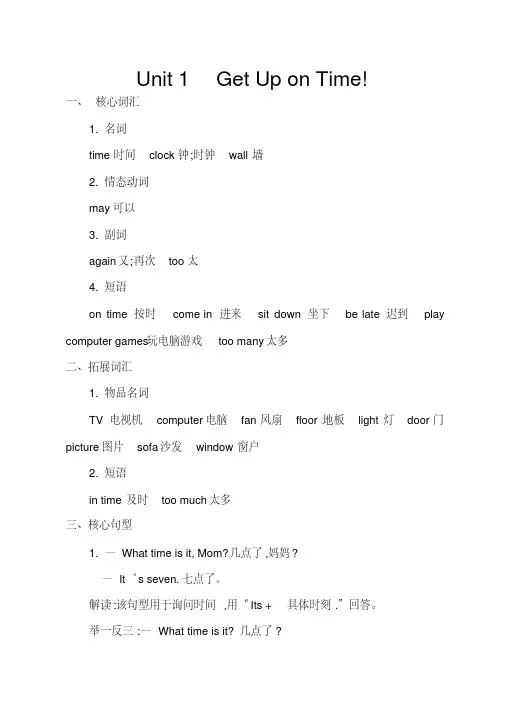
Unit 1Get Up on Time!一、核心词汇1. 名词time时间clock钟;时钟wall墙2. 情态动词may可以3. 副词again又;再次too太4. 短语on time按时come in进来sit down坐下be late迟到play computer games玩电脑游戏too many太多二、拓展词汇1. 物品名词TV电视机computer电脑fan风扇floor地板light灯door门picture图片sofa沙发window窗户2. 短语in time及时too much太多三、核心句型1. —What time is it, Mom?几点了,妈妈?—It‘s seven. 七点了。
解读:该句型用于询问时间,用“Its + 具体时刻.”回答。
举一反三:—What time is it? 几点了?—It’s ten twenty. 十点二十了。
2. —What time do you get up?你几点起床?—I get up at 8: 05. 我八点零五分起床。
解读:这是由what time引导的特殊疑问句,用于询问对方在什么时间做某事。
举一反三:—What time do you watch TV?你几点看电视?—I watch TV at 10:00. 我十点看电视。
四、了解句型Get up! 起床了!解读:该句是以动词原形开头的祈使句,祈使句是用于表达请求、命令或劝告等的句子。
举一反三:Go to bed early. 早点上床睡觉。
Unit 2Be Helpful at Home!一、核心词汇1. 动词sweep打扫;清理water给……浇水clean清扫;清洁2. 名词dish盘;餐具meal餐;饭clothes衣服3. 副词sure当然4. 短语make the bed整理床铺sweep the floor扫地do the dishes洗餐具water the flowers浇花clean the windows擦窗户cook the meal做饭wash the clothes洗衣服二、拓展词汇1. 动词cut 切;割pass传递wash洗cook烹调dry擦干2. 短语of course当然clean the door擦门water the trees浇树dry the dishes 擦干餐具三、核心句型1. —Can you sweep the floor, dear?你能扫地吗,亲爱的?—Yes, of course. 是的,当然。
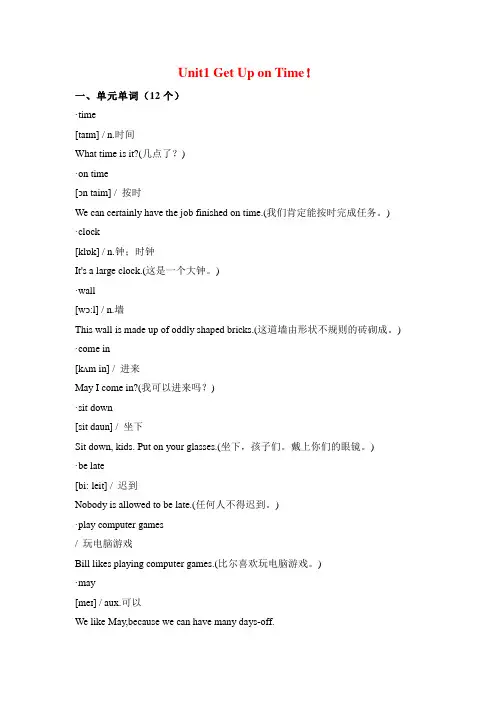
Unit1 Get Up on Time!一、单元单词(12个)·time[taɪm] / n.时间What time is it?(几点了?)·on time[ɔn taim] / 按时We can certainly have the job finished on time.(我们肯定能按时完成任务。
) ·clock[klɒk] / n.钟;时钟It's a large clock.(这是一个大钟。
)·wall[wɔ:l] / n.墙This wall is made up of oddly shaped bricks.(这道墙由形状不规则的砖砌成。
) ·come in[kʌm in] / 进来May I come in?(我可以进来吗?)·sit down[sit daun] / 坐下Sit down, kids. Put on your glasses.(坐下,孩子们。
戴上你们的眼镜。
)·be late[bi: leit] / 迟到Nobody is allowed to be late.(任何人不得迟到。
)·play computer games/ 玩电脑游戏Bill likes playing computer games.(比尔喜欢玩电脑游戏。
)·may[meɪ] / aux.可以We like May,because we can have many days-off.(我喜欢五月,因为可以有很多假期。
)·again[əˈgen] / adv.又;再次Nice to see you again.(很高兴再次见到你。
)·too[tu:] / adv.太The box is too small for him to sit in.(这个盒子太小了,它坐不下。
)·too many[tu: ˈmeni] / 太多It's a trap too many people fall into.(太多人都掉进了这个陷阱中。
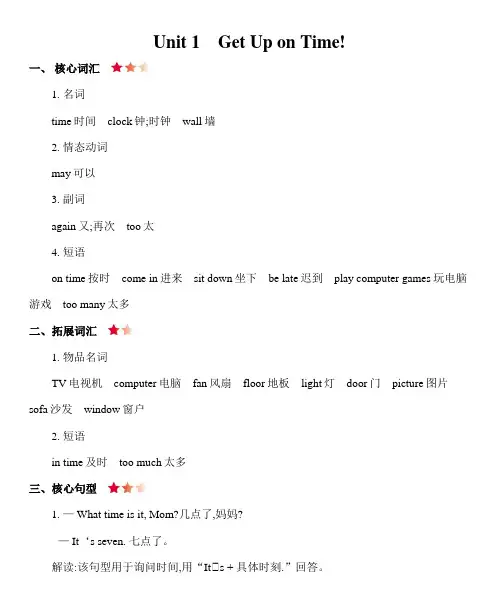
Unit 1Get Up on Time!一、核心词汇1. 名词time时间clock钟;时钟wall墙2. 情态动词may可以3. 副词again又;再次too太4. 短语on time按时come in进来sit down坐下be late迟到play computer games玩电脑游戏too many太多二、拓展词汇1. 物品名词TV电视机computer电脑fan风扇floor地板light灯door门picture图片sofa沙发window窗户2. 短语in time及时too much太多三、核心句型1. — What time is it, Mom?几点了,妈妈?— It‘s seven. 七点了。
解读:该句型用于询问时间,用“It s + 具体时刻.”回答。
举一反三:— What time is it? 几点了?— It’s ten twenty. 十点二十了。
2. — What time do you get up?你几点起床?— I get up at 8: 05. 我八点零五分起床。
解读:这是由what time引导的特殊疑问句,用于询问对方在什么时间做某事。
举一反三:— What time do you watch TV?你几点看电视?— I watch TV at 10:00. 我十点看电视。
四、了解句型Get up! 起床了!解读:该句是以动词原形开头的祈使句,祈使句是用于表达请求、命令或劝告等的句子。
举一反三:Go to bed early. 早点上床睡觉。
Unit 2Be Helpful at Home!一、核心词汇1. 动词sweep打扫;清理water给……浇水clean清扫;清洁2. 名词dish盘;餐具meal餐;饭clothes衣服3. 副词sure当然4. 短语make the bed整理床铺sweep the floor扫地do the dishes洗餐具water the flowers 浇花clean the windows擦窗户cook the meal做饭wash the clothes洗衣服二、拓展词汇1. 动词cut 切;割pass传递wash洗cook烹调dry擦干2. 短语of course当然clean the door擦门water the trees浇树dry the dishes 擦干餐具三、核心句型1. — Can you sweep the floor, dear?你能扫地吗,亲爱的?— Yes, of course. 是的,当然。
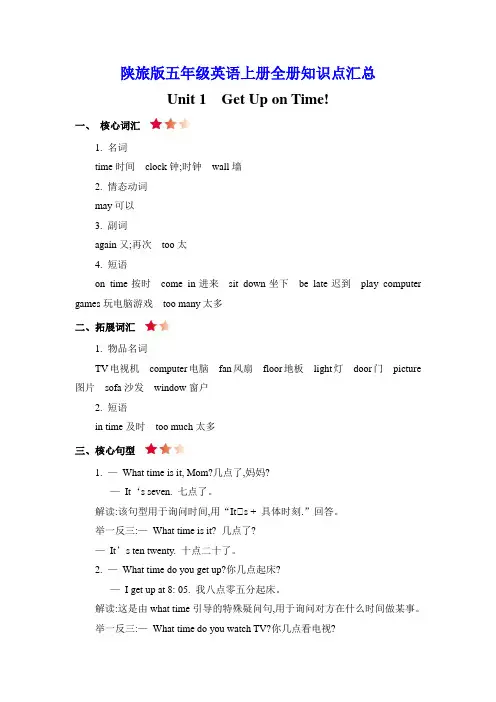
陕旅版五年级英语上册全册知识点汇总Unit 1Get Up on Time!一、核心词汇1. 名词time时间clock钟;时钟wall墙2. 情态动词may可以3. 副词again又;再次too太4. 短语on time按时come in进来sit down坐下be late迟到play computer games玩电脑游戏too many太多二、拓展词汇1. 物品名词TV电视机computer电脑fan风扇floor地板light灯door门picture 图片sofa沙发window窗户2. 短语in time及时too much太多三、核心句型1. —What time is it, Mom?几点了,妈妈?—It‘s seven. 七点了。
解读:该句型用于询问时间,用“It s + 具体时刻.”回答。
举一反三:—What time is it? 几点了?—It’s ten twenty. 十点二十了。
2. —What time do you get up?你几点起床?—I get up at 8: 05. 我八点零五分起床。
解读:这是由what time引导的特殊疑问句,用于询问对方在什么时间做某事。
举一反三:—What time do you watch TV?你几点看电视?—I watch TV at 10:00. 我十点看电视。
四、了解句型Get up! 起床了!解读:该句是以动词原形开头的祈使句,祈使句是用于表达请求、命令或劝告等的句子。
举一反三:Go to bed early. 早点上床睡觉。
Unit 2Be Helpful at Home!一、核心词汇1. 动词sweep打扫;清理water给……浇水clean清扫;清洁2. 名词dish盘;餐具meal餐;饭clothes衣服3. 副词sure当然4. 短语make the bed整理床铺sweep the floor扫地do the dishes洗餐具water the flowers浇花clean the windows擦窗户cook the meal做饭wash the clothes 洗衣服二、拓展词汇1. 动词cut 切;割pass传递wash洗cook烹调dry擦干2. 短语of course当然clean the door擦门water the trees浇树dry the dishes 擦干餐具三、核心句型1. —Can you sweep the floor, dear?你能扫地吗,亲爱的?—Yes, of course. 是的,当然。
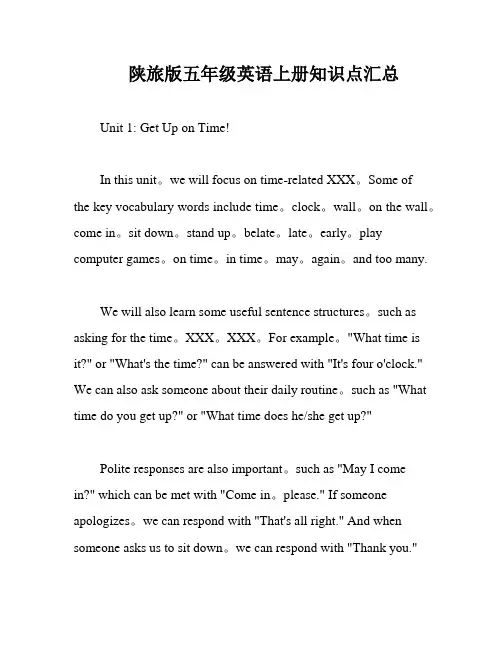
陕旅版五年级英语上册知识点汇总Unit 1: Get Up on Time!In this unit。
we will focus on time-related XXX。
Some ofthe key vocabulary words include time。
clock。
wall。
on the wall。
come in。
sit down。
stand up。
belate。
late。
early。
play computer games。
on time。
in time。
may。
again。
and too many.We will also learn some useful sentence structures。
such as asking for the time。
XXX。
XXX。
For example。
"What time is it?" or "What's the time?" can be answered with "It's four o'clock." We can also ask someone about their daily routine。
such as "What time do you get up?" or "What time does he/she get up?"Polite responses are also important。
such as "May I come in?" which can be met with "Come in。
please." If someone apologizes。
we can respond with "That's all right." And when someone asks us to sit down。
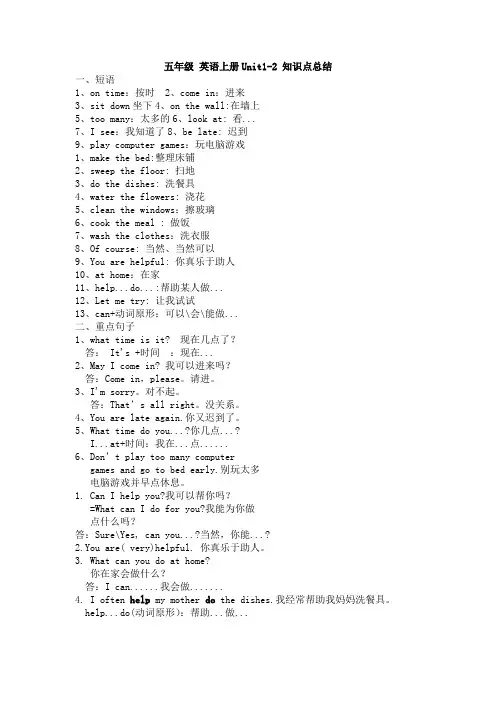
五年级英语上册Unit1-2 知识点总结一、短语1、on time:按时2、come in:进来3、sit down坐下4、on the wall:在墙上5、too many:太多的6、look at: 看...7、I see:我知道了8、be late: 迟到9、play computer games:玩电脑游戏1、make the bed:整理床铺2、sweep the floor: 扫地3、do the dishes: 洗餐具4、water the flowers: 浇花5、clean the windows:擦玻璃6、cook the meal : 做饭7、wash the clothes:洗衣服8、Of course: 当然、当然可以9、You are helpful: 你真乐于助人10、at home:在家11、help...do...:帮助某人做...12、Let me try: 让我试试13、can+动词原形:可以\会\能做...二、重点句子1、what time is it? 现在几点了?答: It's +时间:现在...2、May I come in? 我可以进来吗?答:Come in,please。
请进。
3、I'm sorry。
对不起。
答:That’s all right。
没关系。
4、You are late again.你又迟到了。
5、What time do you...?你几点...?I...at+时间:我在...点......6、Don’t play too many computergames and go to bed early.别玩太多电脑游戏并早点休息。
1. Can I help you?我可以帮你吗?=What can I do for you?我能为你做点什么吗?答:Sure\Yes, can you...?当然,你能...?2.You are( very)helpful. 你真乐于助人。
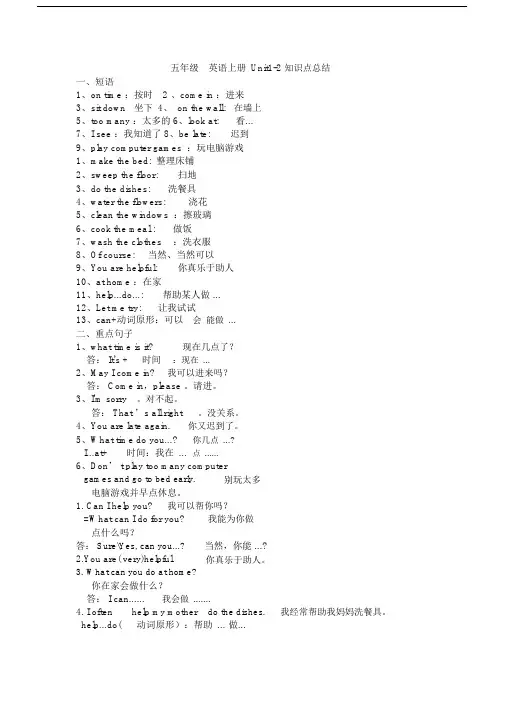
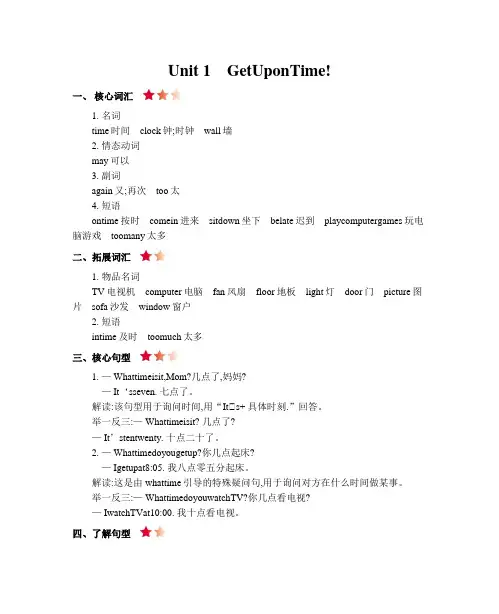
Unit 1GetUponTime!一、核心词汇1. 名词time时间clock钟;时钟wall墙2. 情态动词may可以3. 副词again又;再次too太4. 短语ontime按时comein进来sitdown坐下belate迟到playcomputergames玩电脑游戏toomany太多二、拓展词汇1. 物品名词TV电视机computer电脑fan风扇floor地板light灯door门picture图片sofa沙发window窗户2. 短语intime及时toomuch太多三、核心句型1. — Whattimeisit,Mom?几点了,妈妈?— It‘sseven. 七点了。
解读:该句型用于询问时间,用“It s+ 具体时刻.”回答。
举一反三:— Whattimeisit? 几点了?— It’stentwenty. 十点二十了。
2. — Whattimedoyougetup?你几点起床?— Igetupat8:05. 我八点零五分起床。
解读:这是由whattime引导的特殊疑问句,用于询问对方在什么时间做某事。
举一反三:— WhattimedoyouwatchTV?你几点看电视?— IwatchTVat10:00. 我十点看电视。
四、了解句型Getup! 起床了!解读:该句是以动词原形开头的祈使句,祈使句是用于表达请求、命令或劝告等的句子。
举一反三:Gotobedearly. 早点上床睡觉。
Unit 2BeHelpfulatHome!一、核心词汇1. 动词sweep打扫;清理water给……浇水clean清扫;清洁2. 名词dish盘;餐具meal餐;饭clothes衣服3. 副词sure当然4. 短语makethebed整理床铺sweepthefloor扫地dothedishes洗餐具watertheflowers 浇花cleanthewindows擦窗户cookthemeal做饭washtheclothes洗衣服二、拓展词汇1. 动词cut 切;割pass传递wash洗cook烹调dry擦干2. 短语ofcourse当然cleanthedoor擦门waterthetrees浇树drythedishes 擦干餐具三、核心句型1. — Canyousweepthefloor,dear?你能扫地吗,亲爱的?— Yes,ofcourse. 是的,当然。
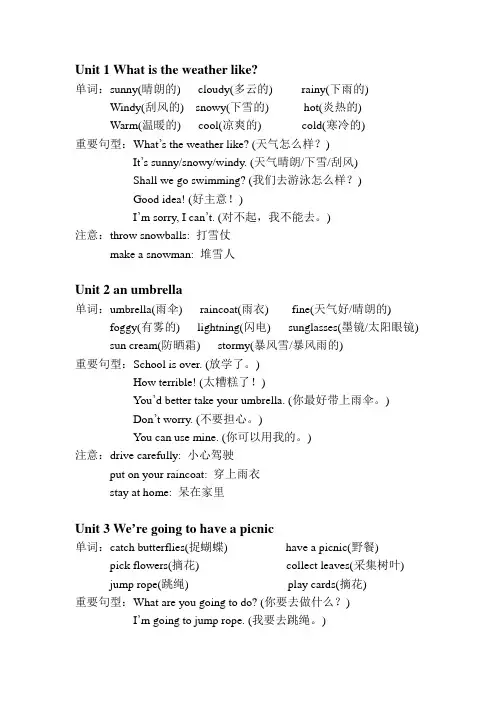
Unit 1 What is the weather like?单词:sunny(晴朗的) cloudy(多云的) rainy(下雨的) Windy(刮风的) snowy(下雪的) hot(炎热的)Warm(温暖的) cool(凉爽的) cold(寒冷的)重要句型:What’s the weather like? (天气怎么样?)It’s sunny/snowy/windy. (天气晴朗/下雪/刮风)Shall we go swimming? (我们去游泳怎么样?)Good idea! (好主意!)I’m sorry, I can’t. (对不起,我不能去。
)注意:throw snowballs: 打雪仗make a snowman: 堆雪人Unit 2 an umbrella单词:umbrella(雨伞) raincoat(雨衣) fine(天气好/晴朗的) foggy(有雾的) lightning(闪电) sunglasses(墨镜/太阳眼镜)sun cream(防晒霜) stormy(暴风雪/暴风雨的)重要句型:School is over. (放学了。
)How terrible! (太糟糕了!)You’d better take your umbrella. (你最好带上雨伞。
)Don’t worry. (不要担心。
)You can use mine. (你可以用我的。
)注意:drive carefully: 小心驾驶put on your raincoat: 穿上雨衣stay at home: 呆在家里Unit 3 We’re going to have a picnic单词:catch butterflies(捉蝴蝶) have a picnic(野餐) pick flowers(摘花) collect leaves(采集树叶)jump rope(跳绳) play cards(摘花)重要句型:What are you going to do? (你要去做什么?)I’m going to jump rope. (我要去跳绳。
【陕旅版】五年级(上册)英语:知识点总结unit 1 知识点单词clock 闹钟wall 墙again 又、再次come in 进来Sitdown 坐下be late 迟到play computer games 玩电脑游戏too many 太多on time 按时句型1、-What time do you get up/go to school/ go to bed/go to work?你几点起床/上学/上床睡觉/去上班?-I get up/go to school/ go to bed at ......我…点起床/上学/上床睡觉.2、What do you do at four o’clock ? 你在四点钟做什么?3、-What time is it? 几点了?-It`s seven. 7点。
4、Don`t play too many computer games and go to bed early.不要玩太多电脑游戏,早点睡觉。
5、-May i come in? 我可以进来吗?-Come in ,please 请进。
第 1 / 9 页6、Look at the clock on the wall.(看墙上的闹钟)7、You are late again.(你又迟到了)unit 2 知识点单词make the bed 整理床铺sweep the floor 打扫do the dishes 洗餐具water the flowers浇花clean the windows擦窗户cook the meal 做饭wash the clothes 洗衣服sure 当然句型1、—Can I help you,grandma? 我可以帮你吗,奶奶?—Sure. 当然。
2、—Can you water the flowers/ sweep the floor/do the dishes?你会浇花/扫地/洗餐具吗?—Yes,of course/sure. 是的,当然。
Unit 1 Get up on time!词形:1.what time=when 什么时候e in 进来3.sit down 坐下4.be late 迟到5.play computer games 玩电脑游戏6.That’s all right没关系7.I see 我明白了我知道了8.draw pictures 画画9.go to work 上班10.do exercise 做运动11.have breakfast 吃早餐12.again 再次13.have(单三)has14.watch(单三)watches15.go(单三)goes16.early 早(反义词)late迟句型1.what time do you get up?你几点起床?I get up at eight.(我八点起床)时间点前用at2.what do you do at seven?你七点干什么?3.What time is it? = What’s the time?几点了4.May I come in? 我可以进来吗?May I sit down? 我可以坐下吗?MayI +动词原形….?5.Look at the clock on the wall.看墙上的钟表e in, please!(请进)这是一个祈使句,祈使句一般以动词原形开头,否定形式是在句首加Don’t7.You are late again.(你又迟到了)8.Don’t play too many computer games and go to bed early(不要玩太多的电脑游戏睡早点)9.What time does he/she/your father go to work?Unit 2 Be Helpful at home!词形1.make the bed(整理床铺)2.sweep the floor(扫地)3.do the dishes(洗碗)4.water the flowers(浇花)5.clean the windows(擦窗户)6.cook the meal/cook meals(做饭)7.wash the clothes (洗衣服)8.have dinner (吃晚餐)9.cross the street (过马路)10.after work (下班后)after class(放学后)after school (放学后)11.of course = sure 当然12.help(形容词)helpful13.at home = in one’s home在家14.let me try(让我试一试)15.every day (每天)16.this(反义词)that17.happy(副词)happily18.can(否定式)can’t19.dish(复数)dishes20.I (宾格)me21.on Sunday 在星期天句型1.Can I help you? 我能帮你吗?What can I do for you?我能为你做什么?2.Can you help me? 你能帮我吗?3.Can you sweep the floor?你能帮我扫地吗?Can you+动词原形…?4.You are helpful. He is helpful.5.Who cooks meal in your home? 在你的家里谁做饭?6.What can you do at home? What can he do at home?7.I often help my mother do the dishes.(我经常帮我妈妈洗碗)8.Can you help me cook the meal?(你能帮我做饭吗?)9.I/He/She can +动词原形情态动词跟动词原形Unit 3 My favorite food is hamburgers. 词形1.my favorite/his favorite/her favorite/their favorite/its favorite…2.China (形容词)Chinese3.good(最高级)best4.in China(在中国)5.too同音词to two6.family(复数)families7.have(单三)has8.there(反义词)here9.be good at擅长10.good(副词well句型1.My favorite food is hamburgers. 我最喜欢的食物是汉堡包=I likehamburgers best.2.What food do you like?你喜欢什么食物3.What’s your favorite food食物/drink饮料/subject科目/color颜色…?同义句:What food/drink/subject…do you like best?4.What about you?=how about you?你呢?5.They’re delicious.它们很可口6.I like Chinese food, too.我也喜欢中国食物7.My family are having our afternoon tea.我的家人正在喝下午茶8.Mom is drinking coffee.妈妈正在和咖啡9.……is/are my favorite…...是我的最爱10.He has a small shop.他有一家商店11.A women wants to buy some hamburgers.一位妇女想买一些汉堡12.She draws well.他画的很好Unit 4 At Table词形1.at table 用餐、吃饭at home 在家at school 在学校2.have breakfast/lunch/supper 吃早餐/午餐/晚餐3.left反义词right4.have(现在分词)having5.Chinese food中国美食6.can(否定式)can’t7.pass传递动词后跟宾格pass /give /help me pass him pass her8.cut(现在分词)cutting9.want(单三)wants10.happy副词happily11.knife(复数)knives12.want = would like want to = would like to 想要13.特殊疑问词总结:what(什么)where(哪里)when=what time(什么时候)Which(哪一个)who(谁)how(怎么样什么方式)句型e the fork with your left hand and use the knife with your right hand.(左手用叉,右手用刀左叉右刀)2.They are having noodles for lunch now. 他们正在吃的午餐是面条3.Not like that不是那样的4.I can’t use chopsticks well.我不能很好地使用筷子5.I want to have some soup.我想喝一些汤6.Would you please pass me the spoon? 句型would you+动词原形你愿意…你能不能7.Here you are给你8.Here are the chopsticks.筷子在这呢9.Pass me the knife, please请把刀子递给我此句话是祈使句祈使句的否定式是在句首加don’t Don’t pass me the knife.10.May I….? Can I…? Can you …? Would you….?Unit 5 Can you tell me the way to thesupermarket?词形1.take a bus 乘坐公共汽车2.Children’s Park 儿童公园3.get off the bus下车4.the way to…去…的路5.go along…沿着…的路6.get to 到达7.on the left 在左边on the right 在右边8.in the sofa 在沙发上9.child (复数)children10.I’d like = I would like11.How about…?=What about …?12.You’re welcome. 不客气13.beside 在..旁边behind 在…后面between 在…之间14.bookstore书店bus stop公共汽车站cinema 电影院句型1.Can you tell me the way to the supermarket?你能告诉我去超市的路吗?同义句How can I get to the supermarket? 我怎么能到达超市?2.There is a cinema near here.一般疑问句Is there a cinema near here?3.Go along …(…路)and you can see…(建筑物)4.You can take a bus at the bus stop and get off at the Park Road. 你可以在公交车站乘坐公共汽车,在公园路下车5.The Children’s Park is beside it. 儿童公园在它旁边6.There is a shop between the school and the park. 在学校和公园之间有一家商店7.Where is … ? …在哪里?Unit 6 How Much Is It?词形1.look(单三)looks2.that对应词this that复数these this 复数those those对应词these3.small反义词big4.we’ll=we will5.they宾格them they形容词性物主代词their6.pair复数pairs7.be going to 打算8.which one 哪一个she宾格her she形容词物主代词her句型1.It looks good. 它看起来很好They look good.他们看起来很好2.How much is it?单How much are they?复3.I would like (to buy) two pairs of socks.我想要两双袜子4.They look / It looks too big for her/for him/for me.5.Would you like to + 动词原形?Would you like + 名词?6.We’ll buy it/them. = We’ll take it/them. buy=take 买7.She is going to buy three pairs of trousers.8.Which one do you like? 你喜欢哪一个?9.Do you mean this one? 你的意思是这一个吗?Unit 7 She looks tall and thin.词形1.know 同音词no2.sport 复数sports3.friend 复数friendse 单三comes5.after class 下课后after school 放学后6.speak 单三speaks7.China(形容词)Chinese8.family复数families9.tall高/ long长(反义词)short矮/短10.woman(女人)对应词man(男人)11.thin胖反义词fat瘦12.woman 复数women13.man复数men14.aunt 对应词uncle15.white白反义词black黑16.old 老/旧反义词young 年轻new新17.in red 穿红色衣服in that red dress 穿那件红裙子的18.they形容词性物主代词their19.be good at+名词be good at + 动词ing 擅长句型1.Do you know the girl? 你知道那个女孩吗?2.She looks tall and thin.她看起来又高又瘦3.My/Her/His name is …我的/她的/他的名字叫….4.She comes from + 国家名5.She speaks English. 她讲英语She can speak a little Chinese.她会将一点点汉语6.She likes sports. 她喜欢运动7.She can run very fast.她可以跑的很快。
新陕旅版五年级英语上册知识点总结Unit1--unit 2单元复习知识点一、短语1.on time:按时2、come in:进来3、sit down坐下4、on the wall:在墙上5、too many:太多的6、look at: 看...7、I see:我知道了8、be late: 迟到9、play computer games:玩电脑游戏1、make the bed:整理床铺2、sweep the floor: 扫地3、do the dishes: 洗餐具4、water the flowers: 浇花5、clean the windows:擦玻璃6、cook the meal : 做饭7、wash the clothes:洗衣服8、Of course: 当然、当然可以9、You are helpful: 你真乐于助人10、at home:在家11、help sb. do sth...:帮助某人做...12、Let me try: 让我试试13、can+动词原形:可以\会\能做...二、重点句子1、what time is it? 现在几点了?答:It's +时间:现在...2、May I come in? 我可以进来吗?答:Come in,please。
请进。
3、I'm sorry。
对不起。
答:That’s all right。
没关系。
4、You are late again.你又迟到了。
5、What time do you...?你几点...? I...at+时间:我在...点......6、Don’t play too many computer games and go to bed early.别玩太多电脑游戏并早点休息。
1. Can I help you?我可以帮你吗?=What can I do for you?我能为你做点什么吗?答:Sure\Yes, can you...?当然,你能...?2.You are( very)helpful. 你真乐于助人。
Unit 1Get Up on Time!一、核心词汇1. 名词time时间clock钟;时钟wall墙2. 情态动词may可以3. 副词again又;再次too太4. 短语on time按时come in进来sit down坐下be late迟到play computer games玩电脑游戏too many太多二、拓展词汇1. 物品名词TV电视机computer电脑fan风扇floor地板light灯door门picture图片sofa沙发window窗户2. 短语in time及时too much太多三、核心句型1. —What time is it, Mom?几点了,妈妈?—It‘s seven. 七点了。
解读:该句型用于询问时间,用“It s + 具体时刻.”回答。
举一反三:—What time is it? 几点了?—It’s ten twenty. 十点二十了。
2. —What time do you get up?你几点起床?—I get up at 8: 05. 我八点零五分起床。
解读:这是由what time引导的特殊疑问句,用于询问对方在什么时间做某事。
举一反三:—What time do you watch TV?你几点看电视?—I watch TV at 10:00. 我十点看电视。
四、了解句型Get up! 起床了!解读:该句是以动词原形开头的祈使句,祈使句是用于表达请求、命令或劝告等的句子。
举一反三:Go to bed early. 早点上床睡觉。
Unit 2Be Helpful at Home!一、核心词汇1. 动词sweep打扫;清理water给……浇水clean清扫;清洁2. 名词dish盘;餐具meal餐;饭clothes衣服3. 副词sure当然4. 短语make the bed整理床铺sweep the floor扫地do the dishes洗餐具water the flowers浇花clean the windows擦窗户cook the meal做饭wash the clothes洗衣服二、拓展词汇1. 动词cut 切;割pass传递wash洗cook烹调dry擦干2. 短语of course当然clean the door擦门water the trees浇树dry the dishes 擦干餐具三、核心句型1. —Can you sweep the floor, dear?你能扫地吗,亲爱的?—Yes, of course. 是的,当然。
陕旅版英语五年级上册复习知识点清单归纳Unit 1Get Up on Time!知识点归纳清单一、核心词汇1. 名词time时间clock钟;时钟wall墙2. 情态动词may可以3. 副词again又;再次too太4. 短语on time按时come in进来sit down坐下be late迟到play computer games 玩电脑游戏too many太多二、拓展词汇1. 物品名词TV电视机computer电脑fan风扇floor地板light灯door门picture图片sofa沙发window窗户2. 短语in time及时too much太多三、核心句型1. — What time is it, Mom?几点了,妈妈?— It‘s seven. 七点了。
2. — What time do you get up?你几点起床?— I get up at 8: 05. 我八点零五分起床。
四、了解句型Get up! 起床了!陕旅版英语五年级上册第二单元Unit 2Be Helpful at Home!知识点归纳一、核心词汇1. 动词sweep打扫;清理water给……浇水clean清扫;清洁2. 名词dish盘;餐具meal餐;饭clothes衣服3. 副词sure当然4. 短语make the bed整理床铺sweep the floor扫地do the dishes洗餐具water the flowers浇花clean the windows擦窗户cook the meal做饭wash the clothes洗衣服二、拓展词汇1. 动词cut 切;割pass传递wash洗cook烹调dry擦干2. 短语of course当然clean the door擦门water the trees浇树dry the dishes 擦干餐具三、核心句型1. — Can you sweep the floor, dear?你能扫地吗,亲爱的?— Yes, of course. 是的,当然。
五年级上册<英语>Unit1-2一、短语1、on time:按时2、come in:进来3、sit down坐下4、on the wall:在墙上5、too many:太多的6、look at: 看...7、I see:我知道了8、be late: 迟到9、play computer games:玩电脑游戏1、make the bed:整理床铺2、sweep the floor: 扫地3、do the dishes: 洗餐具4、water the flowers: 浇花5、clean the windows:擦玻璃6、cook the meal : 做饭7、wash the clothes:洗衣服8、Of course: 当然、当然可以9、You are helpful: 你真乐于助人10、at home:在家11、help...do...:帮助某人做...12、Let me try: 让我试试13、can+动词原形:可以\会\能做...二、重点句子1、what time is it? 现在几点了?答: It's +时间:现在...2、May I come in? 我可以进来吗?答:Come in,please。
请进。
3、I'm sorry。
对不起。
答:That’s all right。
没关系。
4、You are late again.你又迟到了。
5、What time do you...?你几点...?I...at+时间:我在...点......6、Don’t play too many computer games and go to bed early.别玩太多电脑游戏并早点休息。
1.Can I help you?我可以帮你吗?=What can I do for you?我能为你做点什么吗?答:Sure\Yes, can you...?当然,你能...?2.You are( very)helpful. 你真乐于助人。
Unit1 Get up on Time!单元词汇:time 时间 clock 钟,时钟 wall 墙 on the wall 在墙上come in 进来 sit down 坐下(对应词)stand up 起立 be late 迟到 late 迟的(对应词)early play computer games 玩电脑游戏 on time 按时 in time 及时 may 可以 again 又,再次 too many 太多单元句式:1、询问“几点了?”:What time is it ? /What’s the time?It’s four o’clock.2、询问对方做某事的具体时间:What time do you get up?I get up at six thirty.3、询问他人做某事的具体时间:What time does … get up?He /She gets up at six thirty.4、——May I come in?——Come in, please.5、——I’m sorry.——That’s all right.6、——Sit down, please.——Thank you.日常生活相关的动词短语:get up 起床 go to bed 睡觉 wash the face 洗脸 brush one’s teeth 刷牙 have breakfast 吃早餐 have lunch 吃午餐have dinner 吃晚餐 play games 做游戏 play football 踢足球 play basketball 打篮球play ping-pong 打乒乓球 read a book/read books 看书 listen to music 听音乐 draw pictures /draw a picture画画 fly a kite 放风筝 do exercise 做运动 see a film 看电影 do some washing 洗衣服 do some cooking 做饭 do one’s homework 做作业 watch TV 看电视go to school 去上学go home 回家go to work 去上班take photos 拍照片 play the music 播放音乐 sing a song 唱歌 climb the mountain 爬山时间的相关表达:at eleven o’clock 在11点整 at ten fifty-six 在10:56in the morning 在早晨 in the afternoon 在下午 in the evening 在晚上 at noon 在中午 at night 在夜里 after class 下课后 after school 放学后拓展:动词第三人称单数的变化规则(和名词变复数规则基本相同)1.一般情况下,直接加-s,如:get-gets play-plays like-li kes run-runs jump-jumps dance-dances sing-sings swim-swims2.以s. x. sh. ch. o结尾,加-es,如:guess-guesses, wa sh-washes, watch-watches, go-goes, do-does3.以“辅音字母+y”结尾,变y为i, 再加-es,如:study-st udies4、have-has第三人称单数有he ,she ,it, 人名,your father / mother / grandpa /grandma 等。
Unit 2 Be helpful at home!单元词汇:make the bed 整理床铺 sweep the floor扫地do the dishes 洗餐具water the flowers浇花clean the windows擦窗户 cook the meal 做饭wash the clothes 洗衣服 sure 当然 helpful 有帮助的;有用的in my family 在我的家里 clean the blackboard 擦黑板cross the street 过马路 on Sunday 在星期日after work 下班后 from Monday to Friday 从星期一到星期五单元句式:1.—Can I help you,grandma? 我可以帮你吗,奶奶?—Sure. 当然。
2.—Can you water the flowers/ sweep the floor/do the dishes?你会(能)浇花/扫地/洗餐具吗?肯动回答:—Yes,of course/sure.否定回答:—Sorry, I can’t. /I’d like to,but I…3.What +情态动词can+主语+do(动词原形)+其它?答语:主语+can+动词或动词短语。
如:—What can you/he/she do at home?.你/他/她在家会做什么?—I/He/She can make the bed.我/他/她会整理床铺。
这是一个由what引导的特殊疑问句,用来询问对方在家会干什么,句中情态动词can没有人称和数的变化。
4.You are very helpful.你真能干。
He is very helpful.他真能干。
5.Can you help me cook the meal? 你能帮我做饭吗?6.I often help my mother do the dishes. 我经常帮妈妈洗餐具。
7.Let me try. 让我试一下。
8.Great!棒极了!9.Good girl ! 好姑娘!10.Who cooks meals in your home?在你的家里谁做饭?11.What do you do at home?你在家干什么?语法知识点:情态动词can的用法:我是情态动词“can”,若表能力我上前,无论主语怎么变,我的模样都不变,变疑问我提前,变否定”not”添.Unit 3 My favorite food is hamburgers单元词汇:1.China中国 (形容词形式)Chinese中国人、中国的、语文、汉语in China 在中国 china 瓷器2.the USA 美国in the USA 在美国3.fruit 水果(泛指水果时,不可数;表示水果种类时可数)复数fruits4.drink(名词)饮料复数:drinks (动词)喝单三:drinks5.food食物 foot 脚6.chocolate巧克力(不可数)7.hamburger汉堡包复数:hamburgers8.favorite最喜欢的 favorite food 最喜欢的食物 favorite color 最喜欢的颜色 favorite drink 最喜欢的饮料favorite subject 最喜欢的科目 favorite sport 最喜欢的运动9.delicious 美味的10.best 最good好的——(比较级)better更好的——(最高级)best最好的11.coffee 咖啡12.love 喜欢,喜爱(同义词) like13.he(宾格) him单元句式:1.What’s your favorite food/drink/color/fruit?你最喜欢的食物/饮料/颜色/水果是什么?My favorite food/drink/ color is .....我最喜欢的食物/饮料/颜色/水果是...I like…best./ I love …very much.我最喜欢……’s favorite …is…(某某)最喜欢的…是…,2.Li Shan is good at English.李珊擅长于英语。
3.In the USA,we often eat hamburgers .在美国,我们经常吃汉堡。
4.In China, we often eat dumplings.在中国,我们经常吃饺子。
5.My family are having afternoon tea. 我的家人正在喝下午茶。
6.Mom is drinking coffee. 妈妈正在喝咖啡。
7.Dad is drinking tea.爸爸正在喝茶。
8.He loves it very much. 他非常喜欢它。
9.He reads every day. 他每天看书。
拓展:There is much nice food in his shop.他的商店里有很多美味的食物。
The hamburgers there are fresh.那里的汉堡很新鲜。
They look very nice. 他们看起来很美味。
Unit 4 At table单元词汇:table 桌子(复数) tables at table 吃饭、用餐spoon 勺子(复数)spoons knife小刀(复数)knives give 给 chopsticks 筷子fork 叉(复数)forks beef牛肉 would 愿意with 用、借助like 像...一样cut切(单三) cuts (现在分词) cuttinguse 使用(单三)uses (现在分词)usingpass 传递(单三)passes 现在分词)passing单元句式:1.Use the fork with your left hand and use the k nife with your right hand. 左手用叉右手拿刀。
Use the chopsticks with your right hands.2.向对方寻求帮忙的句子:----Would you please pass me the spoon/the chopsti cks/fork?你可以把勺子/筷子/叉子递给我吗?----Here you are./Here it is.给你。
Would you give me some...?你能给我一些...吗?Of course.当然。
would是情态动词,没有人称和数的变化,后接动词原形。
肯定答语:OK./ Of course./ Sure.否定答语:I’m afraid I can’t. Here you are.这句话常用于英语口语中,有以下几种用法:1)、表示把某物递给某人时,意为“给你;拿去吧;这就是你要的东西。
”2)、如果别人找东西,你帮他找到了,你可以说“你要的东西在这里。
”3)、如果你在商店购物,售货员会对你说“你要买的东西在这里。